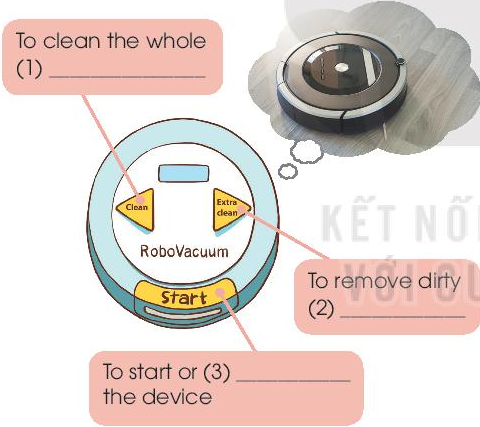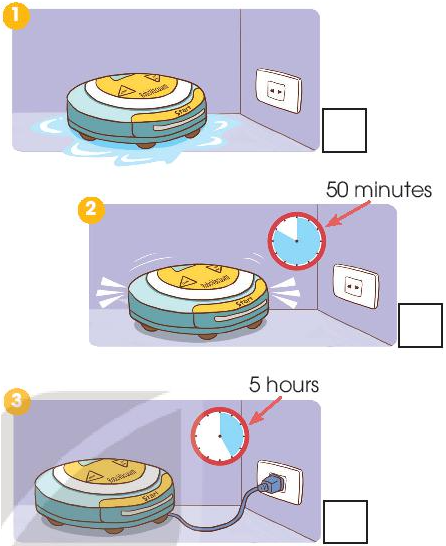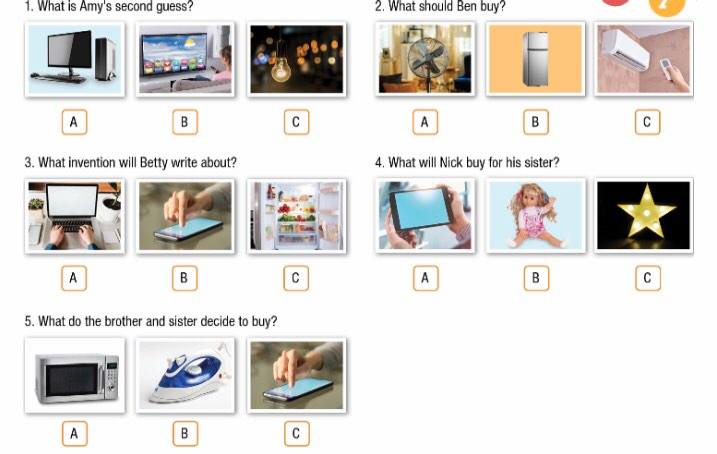3. Listen to five speakers talking about why they became scientists. Which job in Exercise 2 does each person do?
(Lắng nghe năm diễn giả nói về lý do tại sao họ trở thành nhà khoa học. Mỗi người làm công việc nào trong bài tập 2?)
Bài nghe:
1
Nobody's surprised that I studied languages - my father's an English teacher and my mother's a translator. At high school, my best subjects were Spanish and German, but I wanted to know more about the nature of language and communication. So I studied linguistics and computer science at university. I'm interested in artificial intelligence - I've just published my first research paper on robots and how they communicate.
(Không ai ngạc nhiên khi tôi học ngôn ngữ - bố tôi là giáo viên tiếng Anh và mẹ tôi là phiên dịch viên. Ở trường trung học, môn học giỏi nhất của tôi là tiếng Tây Ban Nha và tiếng Đức, nhưng tôi muốn biết thêm về bản chất của ngôn ngữ và giao tiếp. Vì vậy, tôi đã học ngôn ngữ học và khoa học máy tính tại trường đại học. Tôi quan tâm đến trí tuệ nhân tạo - Tôi vừa xuất bản bài báo nghiên cứu đầu tiên của mình về robot và cách chúng giao tiếp.)
2
I work with people who have new ideas about energy sources, like solar and wind power. We're doing research into climate change and trying to discover new ways to produce energy. I want to study ways of protecting the environment using modern technology. This is important work for the future of the planet.
(Tôi làm việc với những người có ý tưởng mới về các nguồn năng lượng, như năng lượng mặt trời và năng lượng gió. Chúng tôi đang nghiên cứu về biến đổi khí hậu và cố gắng khám phá những cách mới để sản xuất năng lượng. Tôi muốn nghiên cứu các cách bảo vệ môi trường bằng công nghệ hiện đại. Đây là công việc quan trọng cho tương lai của hành tinh.)
3
I always want to understand why people do what they do - why do they behave that way? What are they thinking? I'm interested in how we develop from birth to the age of seven. Those seven years are the most important years for the psychological development of a child. I love doing research and analysing data. When I finish my studies, I want to work in a children's hospital.
(Tôi luôn muốn hiểu tại sao mọi người làm những gì họ làm - tại sao họ lại cư xử như vậy? Họ đang nghĩ gì vậy? Tôi quan tâm đến cách chúng ta phát triển từ khi sinh ra cho đến khi 7 tuổi. Bảy năm đó là những năm quan trọng nhất đối với sự phát triển tâm lý của một đứa trẻ. Tôi thích nghiên cứu và phân tích dữ liệu. Khi học xong, tôi muốn vào làm việc trong bệnh viện nhi.)
4
I became interested in archaeology when we were studying ancient Egypt and mummies in school. It was fascinating. When I was fourteen, my class took a school trip to Paris and we visited the famous museum, the Louvre. I spent hours in the Egyptian room and decided that I wanted to know more about people who lived thousands of years ago.
(Tôi bắt đầu quan tâm đến khảo cổ học khi chúng tôi nghiên cứu về Ai Cập cổ đại và xác ướp trong trường học. Nó thật hấp dẫn. Khi tôi 14 tuổi, lớp tôi có một chuyến đi đến trường ở Paris và chúng tôi đã đến thăm bảo tàng nổi tiếng, Louvre. Tôi đã dành hàng giờ trong căn phòng Ai Cập và quyết định rằng tôi muốn biết thêm về những người sống cách đây hàng nghìn năm.)
5
The first time I went scuba diving, I saw a little fish swimming away into the distance, and at that moment I thought 'Oh yes, that's what I want to do - I want to explore oceans, collect evidence about global warming and help to protect marine life.' I love my work - I can't understand why everybody isn't doing my job.
(Lần đầu tiên tôi đi lặn biển, tôi nhìn thấy một con cá nhỏ bơi ra xa, và ngay lúc đó tôi nghĩ 'Ồ vâng, đó là điều tôi muốn làm - tôi muốn khám phá các đại dương, thu thập bằng chứng về sự nóng lên toàn cầu và giúp đỡ bảo vệ sinh vật biển. ' Tôi yêu công việc của mình - tôi không thể hiểu tại sao mọi người không làm công việc của tôi.)
1. A linguist (nhà ngôn ngữ học)
2. A conservationist (nhà bảo tồn)
3. A psychologist (nhà tâm lý học)
4. An archaeologist (nhà khảo cổ học)
5. A marine biologist (nhà sinh vật biển)

Các bài tập cùng chuyên đề
2. Listen to a conversation about RoboVacuum. Fill in each gap in the diagram below with ONE word.
(Nghe cuộc trò chuyện về RoboVacuum. Điền vào mỗi khoảng trống trong sơ đồ dưới đây bằng MỘT từ.)
To clean the whole (1) _______
To remove dirty (2) ________
To start or (3) ________ the device

3. Listen again. Put a tick (✓) next to the correct way and a cross (x) next to the wrong way to use RoboVacuum.
(Lắng nghe một lần nữa. Đánh dấu (✓) bên cạnh cách đúng và dấu gạch chéo (x) bên cạnh cách sử dụng RoboVacuum sai.)

1. Listen and choose the best tittle for the talk.
(Lắng nghe và chọn tiêu đề tốt nhất cho bài nói.)
A. Smart home technology (Công nghệ nhà thông minh)
B. The popularity of smart homes (Sự phổ biến của ngôi nhà thông minh)
C. The future of smart homes (Tương lai của ngôi nhà thông minh)
2. Listen again and fill in each blank with ONE word.
(Nghe lại và điền vào mỗi chỗ trống với MỘT từ.)
Smart homes
You can use your (1)_______to open and close doors and windows.
(2) _______can turn on and off without human control.
The (3) _________rings when someone breaks into the house.
Temperature, lights, and (4) _______at home can be controlled from a distance.
a. Listen to Duc talking to his friend, Bonnie, about inventions. How many inventions do they talk about?
(Hãy nghe Đức nói chuyện với bạn của anh ấy, Bonnie, về những phát minh. Họ nói về bao nhiêu phát minh?)
b. Now, listen and circle the answers.
(Bây giờ, hãy lắng nghe và khoanh tròn các câu trả lời.)
1. What can the crawling mop clean?
(Cây lau nhà bò có thể làm sạch những gì?)
a. babies (trẻ sơ sinh)
b. clothes (quần áo)
c. the floor (tầng)
2. What did Duc read an article about?
(Đức đã đọc một bài báo về điều gì?)
a. new inventions (phát minh mới)
b. weird inventions (những phát minh kỳ quặc)
c. cool inventions (phát minh tuyệt vời)
3. What does the keyboard attach to? (Bàn phím gắn vào gì?)
a. a light (một cái đèn)
b. your legs (chân của bạn)
c. your tablet (máy tính bảng của bạn)
4. What does Bonnie think of geeky jeans?
(Bonnie nghĩ gì về những chiếc quần jeans ngố?)
a. They're not fashionable.(Chúng không hợp thời trang.)
b. They're not portable. (Chúng không di động.)
c. They're not comfortable. (Họ không thoải mái.)
a. Listen to a lecture about the internet. What is the main topic of the lecture?
(Nghe một bài giảng về internet. Chủ đề chính của bài giảng là gì?)
1. The history of the internet (Lịch sử của Internet)
2. The invention that became the internet (Phát minh trở thành internet)
b. Now, listen and circle the correct answers.
(Bây giờ, hãy nghe và khoanh tròn các câu trả lời đúng.)
1. When did the idea of the internet come about?
(Ý tưởng về internet ra đời khi nào?)
a. in the 1960s (vào những năm 1960)
b. in the 1990s (trong những năm 1990)
2. In which country was the first long-distance network created?
(Mạng đường dài đầu tiên được tạo ra ở nước nào?)
a. the UK (Vương quốc Anh)
b. the USA (Mỹ)
3. What was the first message sent over the network?
(Tin nhắn đầu tiên được gửi qua mạng là gì?)
a. “hello” (xin chào)
b. “login” (đăng nhập)
4. What is an internet protocol?
(Giao thức internet là gì?)
a. a set of rules (một tập hợp các quy tắc)
b. a message between two computers (một tin nhắn giữa hai máy tính)
5. What did Tim Berners-Lee invent?
(Tim Berners-Lee đã phát minh ra gì?)
a. the World Wide Web (World Wide Web)
b. a messaging software (một phần mềm nhắn tin)
4. Listen to a man talking about inventions/discoveries. Which two in Exercise 1 does he consider as the most important? Why? Complete the table.
(Nghe một người đàn ông nói về những phát minh / khám phá. Hai cái nào trong Bài tập 1 mà anh ta coi là quan trọng nhất? Tại sao? Hoàn thành bảng.)
|
Invention |
Reason |
|
1 _________________ 2 _________________ |
_____________________ _____________________ |
1. You are going to listen to a dialogue between two friends. Read the questions and the possible answers. What is the dialogue about?
(Bạn sẽ nghe cuộc đối thoại giữa hai người bạn. Đọc các câu hỏi và câu trả lời có khả năng. Đoạn đối thoại nói về điều gì?)
1. Jamie didn’t tell his friends about his vlog because he thinks they ______ .
A won’t support him
B will follow him to be kind
C won’t subscribe to his vlog
2. Which equipment did Jamie pay for?
A the microphone
B the camera
C the editing software
3. Jamie says the activity that takes the most time is ______ .
A editing his videos
B recording his vlogs
C setting up the equipment
4. Jamie gets negative comments about ______ .
A his music
B the quality of his videos
C his appearance
2. Now listen to the dialogue. For questions (1–4), choose the best answer (A, B or C).
(Bây giờ hãy nghe đoạn hội thoại. Đối với các câu hỏi (1–4), hãy chọn câu trả lời đúng nhất (A, B hoặc C).)
4. Listen and match the people (1–4) to the gadgets (a–f). What is each person giving George as a present? There are two extra gadgets.
(Nghe và nối những người (1–4) với những thiết bị (a – f). Mỗi người tặng George món quà gì? Có hai thiết bị còn dư.)
|
People 1. ________ George’s mum2. ________ Richard 3. ________ Craig 4. ________ Jessica |
Gadgets a. smartphone b. tablet c. e-reader d. video game e. smartwatch f. camera |
7. Listen and fill in the missing information.
(Nghe và điền thông tin còn thiếu.)
YOUNG INVENTORS’ COMPETITION
Entry details: Children aged 7–14 may enter. The 0) design must be original.
Rules: Teachers or parents can give guidance. Inventions must 1) ___________ a practical function and solve a problem. Inventions must make 2) ___________ easier.
Application: Send in the following:
A clear 3) ___________ of the invention
A signed form, a photograph and a log book
Awards: Two categories:
Two prizes of £1,000 – age group 7–11
One prize of 4) ___________ – age group 12–14
Entry submission deadline: 5) ___________ next year.
Every student will get a certificate and a home inventors’ book.
4. Listen again. Match speakers 1-5 with statements A-F. There is one extra statement.
(Lắng nghe một lần nữa. Ghép người nói 1-5 với câu A-F. Có một câu bị thừa.)
- Speaker 1:
- Speaker 2:
- Speaker 3:
- Speaker 4:
- Speaker 5:
A. I want to understand how early childhood affects one's behaviour.
(Tôi muốn hiểu tuổi thơ ảnh hưởng đến hành vi của một người như thế nào.)
B. I'm keen on studying how machines can communicate.
(Tôi rất muốn nghiên cứu cách máy móc có thể giao tiếp.)
C. I want to explore oceans and preserve the ocean environment.
(Tôi muốn khám phá các đại dương và bảo tồn môi trường đại dương.)
D. I'm interested in studying our prehistoric ancestors. I want to study the evolution of our planet.
(Tôi thích việc nghiên cứu tổ tiên tiền sử của chúng ta. Tôi muốn nghiên cứu sự tiến hóa của hành tinh chúng ta.)
F. I want to find solutions to nature's problems.
(Tôi muốn tìm giải pháp cho các vấn đề của tự nhiên.)
2 2.09 Listen to a dialogue between Chris and his granddad. Are the statements about Chris's granddad true (T) or false (F)?
(Nghe đoạn hội thoại giữa Chris và ông ngoại của anh ấy. Những câu nói về ông của Chris là đúng (T) hay sai (F)?)
1 He used to phone people from the phone in the sitting room.
2 He used to message people.
3 He didn't use to live near his friends.
4 His mum didn't use to like the loud music in his bedroom.
a. Listen and choose the correct answers.
(Nghe và chọn câu trả lời đúng.)
1. What are Airy Shooz? (Airy Shooz là gì?)
A. shoes that are lightweight (giày có trọng lượng nhẹ)
B. shoes that cool your feet (giày làm mát bàn chân của bạn)
C. shoes that are comfortable (giày thoải mái)
2. Who will find Airy Shooz useful? (Ai sẽ thấy Airy Shooz hữu ích?)
A. office workers (nhân viên văn phòng)
B. people who are shy (những người nhút nhát)
C. people who have smelly feet (những người có bàn chân nặng mùi)
a. Listen to someone talking about artificial intelligence (AI). Why are they talking about it?
(Nghe ai đó nói về trí tuệ nhân tạo (AI). Tại sao họ lại nói về nó?)
1. It’s an interview. (Đó là một cuộc phỏng vấn.)
2. It’s a presentation. (Đó là một bài thuyết trình.)
b. Now, listen and complete the notes.
(Bây giờ, hãy nghe và hoàn thành các ghi chú.)
|
NOTES ABOUT AI |
|
|
Leading company in: |
Artificial Intelligence |
|
Term AI first used in: |
(1) _____________________ |
|
First used to do simple tasks such as: |
Solving word problems Playing computer games Speaking basic (2) ______________________ |
|
Used in different fields: |
Transportation Manufacturing Healthcare Entertainment (3) _____________________ |
|
Some people afraid: |
AI will replace them (4) ______________ |
|
AI still lacks: |
some (5) ________________ human traits. |
b. Read and write True, False, or Not given.
(Đọc và viết Đúng, Sai hoặc Không đưa ra.)
1. Earphones stop you from being noisy.__________________
2. Earphones are good for travel.__________________
3. You can use earphones when making a phone call.__________________
4. Earphones have some problems.__________________
5. Earphones are not very useful.__________________
You will hear five short conversations. You will hear each conversation twice. There is one question for each conversation. For each question, choose the correct answer (A, B, or C).
(Bạn sẽ nghe năm cuộc trò chuyện ngắn. Bạn sẽ nghe thấy mỗi cuộc trò chuyện hai lần. Có một câu hỏi cho mỗi cuộc trò chuyện. Đối với mỗi câu hỏi, chọn câu trả lời đúng (A, B, hoặc C).)

1. Listen to a dialogue between two people. For questions (1-4), choose the correct answer (A,B, or C)
(Nghe đoạn hội thoại giữa hai người. Cho câu hỏi (1-4), hãy chọn đáp án chính xác (A, B, hoặc C).)
1. Jenny didn’t tell people about her videos because she ________________.
A. thinks her friends won’t like them
B. prefers follower who don’t know her
C. only wants her friend to follow
2. Which equiment did Jenny borow?
A. the microphone
B. the ring light
C. the editing software
3. Jenny’s videos show her ___________.
A. singing
B. miming
C. acting
4. Most of the comments Jenny gets are ______________.
A. negative
B. hurtful
C. positive
2. Listen and match the people to the topics (1-6). Which topic is each peson going to do their project on? There are two extra topics.
(Nghe và nối mọi người với các chủ đề từ (1-6). Cái chủ đề nào được mỗi người thực hiện. Có hai chủ đề thừa.)
|
People Ricky __ Carl __ Dianne __ Gemma __ |
1 digital assistants 2 social media 3 3D printing 4 the Internet 5 self-driving car 6 humanoid robots |
4. You will hear five people talking about the most important inventions of the 20th century. Listen and circle the reasons they give for their choices.
(Bạn sẽ nghe năm người nói về những phát minh quan trọng nhất của thế kỷ 20. Hãy lắng nghe và khoanh tròn những lý do họ đưa ra cho sự lựa chọn của mình.)
1 The Internet
a improves people's communication skills.
b provides information about many subjects.
c helps people learn more quickly.
2 Aeroplanes
a let people travel more often.
b make travelling long distances cheaper and quicker.
c make travelling long distances quick and convenient.
3 Computers
a make people's work a lot easier.
b help people do their jobs better.
c provide exciting games in studying.
4 MP3 players
a are small but can store a lot of music.
b can play music with great sound quality.
c can play music for hours without stopping.
5 Spaceships
a help us know more about science and our universe.
b help us find out life in space.
c help us understand other inventions.






